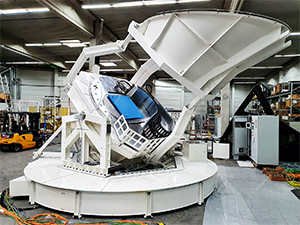
Posted to News on 12th Nov 2021, 00:00
Setting the limits of deep space research telescopes
High in the arid Atacama Desert, a new observatory is aiming to answer big questions about our universe. Currently under construction, the Simons Observatory will study the cosmic microwave background (CMB) – the radiation signature of the Big Bang. The observatory will include telescopes and antennas manufactured by CPI Vertex Antennentechnik, which feature Stromag Series HGE and HEG geared cam limit switches to limit their movements as they observe deep space.

Telescopes and antennas around the world are constantly scanning the night sky, observing across the electromagnetic spectrum as part of ground-breaking research into the nature of our universe. While the first telescopes relied solely on visible light, now observatories can detect radio and microwaves. An area that has spurred intense research is the CMB, a remnant of the Big Bang. Highly sensitive telescopes and antennas located far from sources of electromagnetic interference (EMI) observe deep space at this spectrum to research the creation, expansion and composition of our universe.
As the Earth rotates, telescopes and antennas must move axially and elevate to keep aligned with a particular observed section of the sky. In addition, in some cases the dishes and receivers must be rotated to ensure accurate reception of signals from space. The rotating ranges of the telescopes are limited because of cabling, cooling hoses and mechanical constraints, which is where Stromag geared cam limit switches come in, providing slowing and stopping functionality at pre-set limits.
CPI Vertex Antennentechnik is a worldwide supplier for ground stations, precision antenna systems and radio telescopes. An expert in this field, the business provides systems to space agencies and leading academic research projects. Located in Duisburg, Germany, CPI Vertex Antennentechnik utilises Stromag geared cam limit switches to protect the highly sensitive equipment from damage in case of malfunction, for example, after component failures. Thus, the Stromag geared cam limit switches are important elements within the telescopes.
The Simons Observatory is being constructed at 5,200 meters (17,000 ft) inside the Chajnantor Science Preserve, making it one of the highest telescope installations the world. It will join the operational Atacama Cosmology Telescope (ACT) and the Simons Array to aid in the next generation of CMB research, adding several new telescopes1 and cameras with state-of-the-art detector arrays. The observatory is operated and funded by the Simons Foundation, which includes the University of Pennsylvania; Princeton University; the University of California, San Diego; the University of California, Berkeley; and the Lawrence Berkeley National Laboratory, as well as other institutions worldwide.
“To support the project, we provided Series HGE and HEG geared cam limit switches,” says Marco Niehnus, global product manager for controls at Stromag. “These limit the axial, elevation and polarisation movements of the telescopes and antenna. Devices offer two contact points at both the upper and lower (or left and right) limits, the first for initially slowing the movement and the second for a complete stop. We design each geared cam limit switch to offer a certain number of turns from the upper to the lower limit, which we tailor by modifying the gear ratio. We can offer a switching point repeatability to 1/1000th of the travel pass, which for 20 m of travel would equate to 20 mm accuracy of limit switch adjustment. This level of accuracy is highly beneficial for sensitive equipment collecting scientific data like a telescope or antenna.”
Stromag geared cam limit switches can be adjusted by almost anyone. By adjusting a worm gear, operators can set the limit as desired. The worm gear is self-locking, which ensures that once set, there will be no subsequent change in position. Encoder integration is also available to provide the information to the control systems regarding the current position in between the contacts. The contacts are responsible for the safe stopping of the antenna at the end of its travel range.
“Our proximity to CPI Vertex Antennentechnik means that, when possible, we can talk directly with their teams to ascertain specifications and requirements. For challenging applications such as antennas and telescopes, this is invaluable. We can take an active part in each project during initial design phase from a limit switch perspective, which helps us to deliver the best possible solution,” Marco enthuses.






